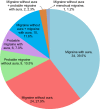What is the actual prevalence of migraine?
- PMID: 30106228
- PMCID: PMC5991594
- DOI: 10.1002/brb3.950
What is the actual prevalence of migraine?
Abstract
Objectives: Population prevalence studies of migraine report prevalence rates of between 2.6 and 21.7%, with an average of ~12%. However, migraine prevalence among neurologists is reported to be significantly higher, between 27.6% and 48.6%. Increasing knowledge of the protean manifestations of migraine may explain this difference. Similarly, under-recognition of migraine in control groups may explain the lack of genetic and biomarker findings in this disorder. We therefore sought to determine the prevalence of migraine in an admixed group of individuals with varied knowledge of migraine symptomatology.
Methods: Attendees at the Australian and New Zealand Association of Neurologists Annual Scientific Meeting (ANZAN ASM) 2017 were surveyed anonymously. Those surveyed included three groups: neurologists, neurology trainees, and others including nonclinical researchers, members of lay organizations, and representatives of the pharmaceutical industry.
Results: In total, 313 of 606 attendees responded (51.7%). 65.9% of neurologist, 57.4% of trainee, and 52.5% of others respondents had a personal history of migraine, with the difference between neurologists and others being statistically significant (p = .03). Migraine in migraineurs and nonmigraine headache in nonmigraineurs were nearly all self-diagnosed. Among neurologist migraineurs, 51.2% experienced migraine with aura and 43% migraine without aura.
Conclusions: Migraine prevalence is significantly higher in neurologists compared to non-neurologists and at least 2-3 times higher than reported in population prevalence studies. This may be due to significant under-recognition of migraine in non-neurologists. This under-recognition of migraine may significantly influence the search for genetic predictors and biomarkers of migraine.
Keywords: epidemiology; genetics; migraine; neurology; pain; prevalence.
© 2018 The Authors. Brain and Behavior published by Wiley Periodicals, Inc.
Figures
References
-
- Alstadhaug, K. B. , Hernandez, A. , Naess, H. , & Stovner, L. J. (2012). Migraine among Norwegian neurologists. Headache, 52(9), 1369–1376. https://doi.org/10.1111/j.1526-4610.2012.02216.x - DOI - PubMed
-
- Anttila, V. , Stefansson, H. , Kallela, M. , Todt, U. , Terwindt, G. M. , Calafato, M. S. , … Artto, V. (2010). Genome‐wide association study of migraine implicates a common susceptibility variant on 8q22.1. Nature Genetics,42(10), 869–873. https://doi.org/10.1038/ng.652 - DOI - PMC - PubMed
-
- Burch, R. C. , Loder, S. , Loder, E. , & Smitherman, T. A. (2015). The prevalence and burden of migraine and severe headache in the United States: Updated statistics from government health surveillance studies. Headache, 55(1), 21–34. https://doi.org/10.1111/head.12482 - DOI - PubMed
-
- Chasman, D. I. , Schürks, M. , Anttila, V. , de Vries, B. , Schminke, U. , Launer, L. J. , … Ernst, F. (2011). Genome‐wide association study reveals three susceptibility loci for common migraine in the general population. Nature Genetics, 43(7), 695–698. https://doi.org/10.1038/ng.856 - DOI - PMC - PubMed
-
- De Vries, B. , Anttila, V. , Freilinger, T. , Wessman, M. , Kaunisto, M. A. , Kallela, M. , … Kubisch, C. (2016). Systematic re‐evaluation of genes from candidate gene association studies in migraine using a large genome‐wide association data set. Cephalalgia, 36(7), 604–614. https://doi.org/10.1177/0333102414566820 - DOI - PubMed
MeSH terms
LinkOut - more resources
Full Text Sources
Other Literature Sources
Medical
Miscellaneous


